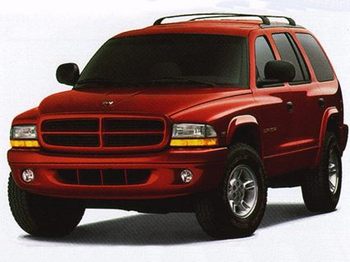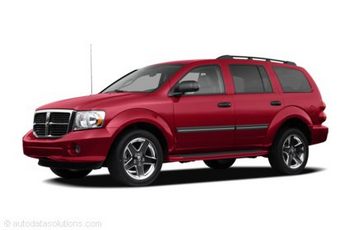The full-sized
Dodge Ramcharger, predecessor to the
Dodge Durango,
was introduced in the mid 1970's when the American automotive market
was seeing a new kind of truck, though it was labeled a station wagon.
They typically bore a pickup truck front end and chassis with a solid
cap, and the interior was unlike the typical pickup with a cap in that
these new "station wagons" had a second row of seats. This allowed
people the seating and hauling capacities of a family station wagon,
but with the abilities, both on and off-road, of a pickup truck. Models
such as the Chevrolet Blazer (known by some as the K5), Ford Bronco,
Plymouth Trail Duster, and Ramcharger represented this new class of "car" that quickly became very popular.

The Dodge Ramcharger was based on the popular Dodge Ram 1500 and
offered a variety of engines. Another option in several years of the
Ramcharger production was the option of a removable "cap". Times
changed quickly, and with the influx of very efficient imported cars
and trucks, along with the steady raise in fuel prices, these new
truck-styled station wagons became less popular, and by the mid 1990s,
these truck based models earned themselves a new class names and the
"SUV" was born. Meaning Sport Utility Vehicle, the class included any
mid-sized truck based vehicle with multiple seating rows and the option
of four wheel drive. The Bronco and Blazer models would continue but in
1994, Dodge did not bring the Ramcharger back for production when they
introduced the second generation of their popular Dodge Ram. There was
an outcry from Dodge enthusiasts who wanted an SUV with the new look of
the Ram series, but it would be several years before their prayers
would be answered. But, in 1998, Dodge released a new SUV and this one
would quickly grow to be every bit as popular as the Ramcharger. This
new SUV was built on the Dodge Dakota platform, and was name the Dodge
Durango.

The new model Durango was a mid-sized SUV. However, with a variety of
new engines and an extra row of seats, the Durango offered all of the
abilities and interior capacities of the Ramcharger. Dodge had
originally intended to launch a Dakota-based SUV in the late
1980s/early 1990s, but this was the time around which Jeep had intended
to launch its "luxury" SUV in the form of the Grand Cherokee, so Dodge
held off.
The first two years of the Durango came with an option of three Magnum
engines. The entry level engine was a 3.9 liter making 175 horsepower
and 225 ft. lb. of torque, the mid level engine was a 5.2 liter making
230 horsepower and 300 ft. lb. of torque, and the premium engine
offering was a 5.9L building 245 horsepower and 335 ft. lb. of torque.
All three of these engines came fitted up to a 4 speed automatic
transmission and were offered in either two or four wheel drive.
Starting in 2000, the 5.2 liter engine was dropped to make room for the
new 4.7 liter "PowerTech" engine which made 235 horsepower and 295 ft.
lb. of torque which was slightly better than the 5.2 liter engine, but
kept the 5.9 liter engine going as the "performance engine". The
Durango was built to lead its class, and that was exactly what it did.
While it had a sporty look and feel the Durango was built to be a work
horse. The 5.9L models are capable of towing over 7,300 pounds, and the
interior hauling capacity is listed as being around 1,800 pounds, and
with an overall capacity of 9,100 pounds, the Durango will move more
cargo than many full-sized SUVs! Add to that the fact that it has
seating for eight people; there aren't many people that can complain
about the Durango not being "big enough".
That performance engine was also what was found in the 1999 special
edition Durango. That special model was named the Shelby SP360 Durango.
Carrying the fabled name of legendary performance genius Carroll
Shelby, and packing 360 horsepower and 412 ft. lb. of torque, this was
one mean SUV. Offered only as a four wheel drive, and with an
automatic, the SP360 still had the firm footedness of an SUV, but had
the bottom end acceleration of a sports car. However, performance was
not the only thing differentiating the SP360 from the other Durango
models. They came with a dressed up interior with the classic Shelby
logo embroidered on the seat backs, and on the outside, it was obvious
that this was no regular SUV. The SP360 featured a complete new look
thanks to the Shelby front and rear fascias as well as the side skirts
and hood. Even the head lights and tail lights were changed, and
massive lower fascia-mounted driving lights gave the SP360 a
euro-sports car look. The only downfalls to these strong running and
cool looking SUVs was the price and production numbers as they were
very rare, and with a price tag of around $59,000 new, they were more
expensive than many people were hoping.
The 2004 model year brought about the second generation of the Durango,
and with it, first refresh of the model. The Durango got a bigger,
beefier feel with the new generation, moving it from compact SUV to a
full sized SUV and with it a new set of engine offerings. The 4.7L
PowerTech was still offered and received no change in performance, but
the entry level was a new, more powerful V6, displacing 3.7L and making
210 horsepower. The premium engine also got a big jump thanks to the
newly offered 5.7L HEMI. This rebirth of a classic engine offered a new
Durango driver 335 horsepower and 370 ft. lb. of torque. The 2nd
Generation of the Durango also features some new technological items
such as rear seating DVD players, satellite radio, and front/rear
heating and cooling. Starting in 2007, the Durango was joined by a sort
of luxury-minded sibling SUV from Chrysler, named the Aspen. The Aspen
is simply a Durango with some added chrome and other aesthetic
features; when the Durango received a mid-generation refresh that
included some slight physical changes to the grille and headlights, it
looked more like the Aspen.
While the Dodge Durango doesn't have the rough and tumble look of the
Ramcharger, it has proven to be a great replacement and provides a
reasonably priced SUV for anyone who wants a sporty, quick vehicle
which can also haul around a group of friends or family, and it can
also pull something as big as a mid sized car on a trailer. All in all,
the Durango is near the top of every category because with its roomy
interior and powerful engines, there are very few things that it cant
do compared to other SUVs.
- Patrick Rall